Rachael Taylor Ladies in Black
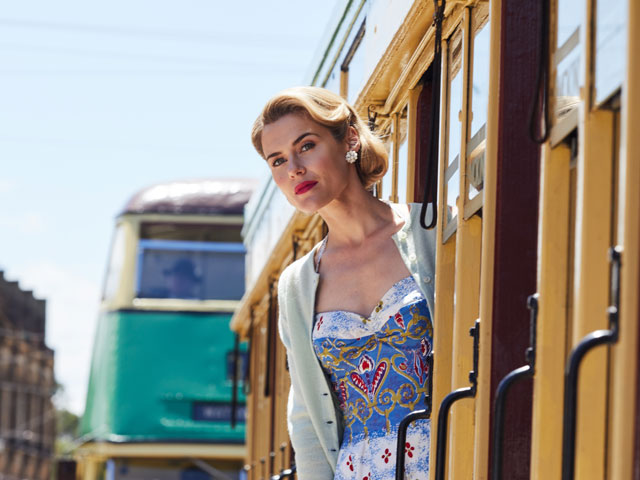
Set in the Summer of 1959
Cast: Shane Jacobson, Rachael Taylor, Vincent Perez, Angourie Rice, Susie Porter, Julia Ormond, Geneviève Lemon
Director: Bruce Beresford
Genre: Comedy
Rated: PG
Running Time: 109 minutes
Synopsis: Set in the summer of 1959, when the impact of European migration and the rise of women's liberation is about to change Australia forever, Lisa, aged sixteen, takes a holiday job at the prestigious Sydney department store, Goode's. There she meets the "ladies in black".
Beguiled and influenced by Magda, the vivacious manager of the high-fashion floor, and assisting sales ladies Patty and Fay, Lisa is awakened to a world of possibilities. As she grows from a bookish schoolgirl into a glamorous and positive young woman, the impact they have on each other will change all their lives.
Ladies in Black
Release Date: September 20th, 2018
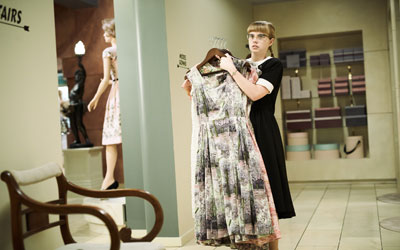 About The Production
About The Production
FAX from Bruce Beresford to Sue Milliken, 6 December 1994
"… I have just read a funny and touching Aussie novel by Madeleine St John (who was at uni with me) and I think we should buy it.
Please read it and give me your opinion. It's short, called The Women In Black.
About ladies working at David Jones in 1958."
From Page To Screen
The Women in Black, published in 1993, was the first novel written by Madeleine St John, who had attended the University of Sydney alongside two-time Academy Award® nominated film director Bruce Beresford.
The book explores the awakening into womanhood of a 16-year-old girl working at the fictional Goode's department store in Sydney over a summer in the late 1950s, and explores themes of tolerance versus intolerance of those who are different, and the aspirations and frustrations of women in the days just before second-wave feminism. One day in 1994, Bruce Beresford was lunching with Clive James in London, who had also attended the University of Sydney, when the writer recommended the book to the film director as one of the most engaging novels that he'd ever read.
Beresford recalls; "Clive added that of all the people we knew at university, Madeleine St John was the most brilliant. She was quite a character; she went to England when she was in her 20s, like most of us did in those days, and she wrote the book when she was in her 50s. It was very successful and had wonderful reviews."
The director immediately purchased a copy of the novel, found it impressively observant and funny, got in touch with St John " who was still living in London " and said to her, "I want to make a film of your book."
That desire would come to fruition, but it would take 24 years to do so.
The book engaged Beresford deeply because it dealt with a theme that was of interest to him; the post-war arrival of migrants in Australia in the 1950s and 1960s.
"This was an era that I lived through," explains Beresford. "I grew up near two migrant camps, so I met a lot people who'd had these terrible experiences in Europe, including a lot of the migrant kids at school. The way that Madeleine handled the theme was very compassionate, very funny and insightful, and not at all didactic. The book has a universal theme, dealing with people's in-borne prejudices against foreigners, but it does so with a great degree of humour, which is the perfect way to handle the story of migrants and their positive impact on society."
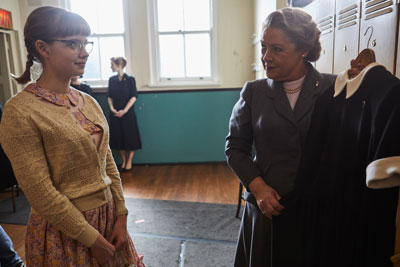 Renowned producer Sue Milliken heard about the book and the idea of a film adaptation in a fax sent by Beresford in December 1994 (and reproduced above).
Renowned producer Sue Milliken heard about the book and the idea of a film adaptation in a fax sent by Beresford in December 1994 (and reproduced above). Milliken and Beresford had known each other since the early 1980s, when his early work made a deep impact on the young producer.
"I felt of all the very fine Australian directors emerging at that time Bruce's films were the most cinematic; they felt like big movies," recalls Milliken. "I'd met him once or twice, but mostly admired his films from afar. One day in the mid-1980s, I heard that he was coming back from overseas to make The Fringe Dwellers and was looking for a producer."
Mutual acquaintances told Beresford to talk to Milliken, and vice versa.
"We made the film, it was a success, and I loved working with him," says Milliken. "You either get on with people or you don't. I'm always challenged by him and that is the most interesting way to work with people, when they challenge you intellectually. Once we'd made The Fringe Dwellers, we started talking about what we'd do next, and our working relationship went from there."
The pair went on to make the features Black Robe; Paradise Road, which starred Frances McDormand, Glenn Close, and Cate Blanchett; and Sydney: A Story Of A City. Beresford also made many films in Hollywood, including Driving Miss Daisy, which in 1990 won four Academy Awards®, including for Best Picture. Milliken continued to produce films in Australia, such as Sirens and Dating The Enemy.
On reading St John's novel at the end of 1994, Milliken was drawn to the same themes that had resonated with Beresford.
"The book has a very strong point of view about intolerance and ignorance," explains Milliken. "The Anglo Australians in the book aren't bad people, but they don't understand that these new arrivals are the same as they are, and that each side has something to learn. You can change people's perception with humour, whereas if you lecture to them they'll often turn away. I think the book does this beautifully."
Milliken acquired an option on the film rights, and asked Beresford what his thoughts were about engaging a screenwriter.
"Bruce said 'I'll write the script,'" recalls Milliken. "A few months went by and I said, 'What about the script?' And he said 'I'm going to do it.' A few more months went by and finally I said to myself; 'I think I could adapt this book and I'm going to have a go', which I did. I sat down and wrote the first draft. Curiously, the film that we're filming now is not far different from that first draft. St. John's novel is so beautifully simple, it just steps off the page into a screenplay."
Beresford adds: "Sue did her first draft of the script while I was shooting a film, then I did a draft, then I went through both and combined bits and pieces together. Both of us had done a pretty close adaptation of the novel to begin, so we were heading in a good, similar direction."
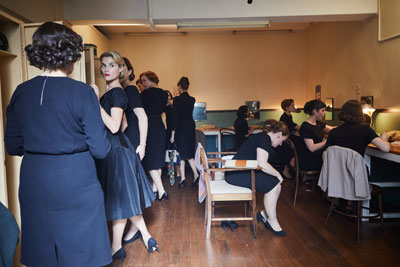 Over the intervening years, Milliken's drafts would continue to go to Beresford, who would write further drafts, then back again, the two never actually sitting together in the same space and writing.
Over the intervening years, Milliken's drafts would continue to go to Beresford, who would write further drafts, then back again, the two never actually sitting together in the same space and writing. "I'd complain about something he'd done," adds Milliken, "then he'd quietly take out something I'd done. Bruce wrote the last pass, which made some minor changes, and only to make the film keep moving did we add something or take something away. It was perhaps an odd sort of collaboration, but it worked for us."
Raising the finance for the film was a process that would take many years, but during that time, Beresford's conviction that Ladies In Black would be made never wavered.
"Although it was difficult, we never stopped thinking about it and Bruce never gave up on it," adds Milliken. "He always said 'I'm going to make this film.'"
At a crucial moment, in 2007, producer Allanah Zitserman entered the story. "I'd just founded a film festival in Dungog, NSW, and I wanted to have a master class component to the festival," recalls Zitserman. "I knew that my dream inaugural master class would be with Bruce Beresford. His films were inspiring to me growing up in Australia; particularly Puberty Blues, Don's Party and Breaker Morant. I asked Bruce and he kept saying he was too busy, but I kept bugging him in my gentle persistent way, and eventually he said, 'Oh, I'm coming, all right!'"
Beresford brought a copy of St John's book with him to the master class, told Zitserman that he was making the film based on it, and left her the copy.
"I read it and fell in love with the story," Zitserman says. "I was a refugee, so that part of the story I strongly related to. The story is also about women finding themselves and wanting to have opportunities. It was inspiring on so many levels. I mentioned it to Stavros, my partner, and he said, 'Oh, you should produce that', and I said 'Sure, as if that would happen...'"
Madeleine St John passed away in 2006, and Beresford was her literary executor. The musician Tim Finn had acquired the rights from the estate to make a musical version of the story, which premiered at the end of 2015 and was a big success.
In early 2016, Zitserman contacted Beresford to share stories about their current projects. "Out of the conversation, Bruce said, 'I haven't made Ladies In Black and I'm wondering if you might want to be involved'," she recalls. "It was an extraordinary moment."
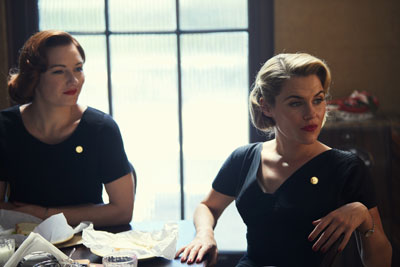 Zitserman contacted Sue Milliken, who was enjoying retirement from filmmaking. They thrashed out strategies and a working relationship, and one year later, they were shooting the film.
Zitserman contacted Sue Milliken, who was enjoying retirement from filmmaking. They thrashed out strategies and a working relationship, and one year later, they were shooting the film. "We attracted such fantastic support from Create NSW, who were on-board from the development stage, allowing us the opportunity to hone crucial pitching materials," says Zitserman. "We were also incredibly fortunate to have Screen Australia's support as a significant investor."
"It was wonderful to have all this enthusiasm for the story. I could never have gone back to make another film except for something like Ladies In Black," says Sue Milliken.
"We are in an era where women are coming to the forefront, where intolerance to immigrants and refugees is again a part of our experience, globally, and so suddenly this book written 25 years ago is incredibly timely."
The Late 1950s
On the surface, Ladies In Black is about the joyful experiences a diverse group of women have together over the course of a Sydney summer, but underneath, subtly and carefully, sit important themes which were relevant in 1959 and continue to be today.
"Immigrants can change and inspire people; they add a component which can be an incredible way for a place to evolve," says Allanah Zitserman, "but this was a tough time because some Australians were quite uncomfortable and confused by these newcomers."
It was a complex time globally, with ongoing movements of populations caused by the fractures of WW2 and political shifts in the wake of Communism and the Cold War.
In Australia, 'refugees' was often shortened to 'reffos', and 'continentals' was a nickname for European immigrants (to distinguish them from the British; they were from the Continent of Europe); some characters in LADIES IN BLACK use this now dated parlance. In many countries, women still weren't expected to work, or if they did, it was in very specific types of roles. Going to university was not something that many Australians felt women should be doing.
"The women who work at Goode's need to be well presented and disciplined," says actress Noni Hazlehurst, who plays Miss Cartwright. "They had a chance to be independent, to earn their own money, but they're not highly educated."
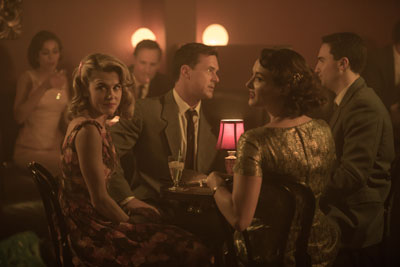 "During the rise of consumerism after WW2, fashion was held up as a carrot to women to get them out of the workforce that they'd been enjoying during the war, and back into the home along with shiny new appliances. They didn't have a lot of other opportunities in their lives."
"During the rise of consumerism after WW2, fashion was held up as a carrot to women to get them out of the workforce that they'd been enjoying during the war, and back into the home along with shiny new appliances. They didn't have a lot of other opportunities in their lives." The powerful story arc of Ladies In Black is one in which Lisa and the other characters grow and emerge into a reality which is more embracing of difference and more liberating for women.
"There are a lot of rich layers that will appeal to audiences, and will encourage conversations about these themes," continues Hazlehurst. "Through a safe medium like film, you can get people to reflect on their own attitudes about these issues."
Zitserman adds: "What's exciting is that the messaging is so current. Women are still trying to achieve full equality, and some people are still uncomfortable with new people entering their country, so the film has very powerful messages, but it's told in a subtle and careful way. Audiences will enjoy an extraordinarily entertaining film, but also walk away with ideas that they can reflect upon and be inspired by."
Casting And Characters
Although Lisa Miles and her journey are at the heart of the film, Ladies In Black is, as its name suggests, an ensemble story. Casting Director Christine King worked over several months with Beresford, Zitserman and Milliken to find the best actors who could together weave the best telling of the story.
"If you take one character out, it doesn't survive without them," says Sue Milliken. "We were fantastically lucky to put together the cast we did, and we have largely to thank Christine King. It was a long, slow process."
Once the cast of 50 had been found, the producers brought together the ensemble from across Australia and internationally for a cast read-through.
"Everybody immediately gelled," says Zitserman. "It was an incredible experience. Getting them to the read-through was difficult because they had to come in from around the globe, but it was important to Bruce to have as many of the cast here as possible. It was a great opportunity to see everyone working together, and so inspiring to see the words come off the page and start to come to life."
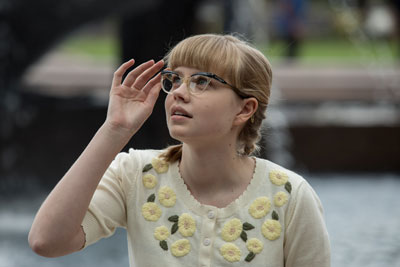 The Ladies In Black
The Ladies In BlackWith young Lisa, the audience enters the 5th floor of Goode's to find, at first, an environment riddled with tensions and undercurrents.
"Goode's is a setting that allows for these very different women with very different issues and experiences and backgrounds to come together," says Allanah Zitserman. "The combination of these particular women in that setting together provides for a fantastic drama, and a very entertaining experience."
Julia Ormond, who plays Magda, adds: "Lisa pulls different aspects out of the ladies in black and encourages them to interrelate in ways that they learn from each other and grow. Lisa has an impact on them; it's not just them having an impact on her."
Lisa Miles – Portrayed By Angourie Rice
Lisa has just finished her Leaving Certificate examinations, and takes a summer job at Goode's. She has nice, conventional parents, but her father is stridently opposed to her going to university, which he sees as a waste of time for anybody, and particularly for girls who will just get married and have a family.
Initially, this young, bookish girl in glasses and braids seems underwhelming to the Ladies' Cocktail staff, Fay and Patty. They push her around, and Lisa seems to do everything wrong. However, she soon demonstrates her intelligence and hard-work ethic.
She will be greatly encouraged in her dreams by Magda, the Slovenian immigrant who runs Model Gowns, encouraging Lisa to grow from an awkward teenager into a young woman full of possibilities.
"Lisa knows that she's very intelligent," says Sue Milliken. "She knows that her life is going to be very different to the life her parents have. She'll be the first person in her family to go to university, and that was a very common experience in the 1950s. When 1959 rolls into the 1960s, the world is going to change and Lisa will change with it."
Allanah Zitserman adds: "Lisa's story is juxtaposed beautifully against the fabric of Sydney at a time when immigrants were arriving and changing the way we eat, the way we dress, the music we listen to, the films we watch, the literature we read. In a way, Lisa's coming of age reflects Sydney's coming of age, and Australia's coming of age."
Lisa would be played by the Australian actress Angourie Rice, just 16-years-old during filming. With Sofia Coppola's The Beguiled and Marvel Studio's Spider-Man: Homecoming already under her belt, Rice's agent was sent the script, before auditioning for Bruce Beresford in Toronto, where he was then in production on another project.
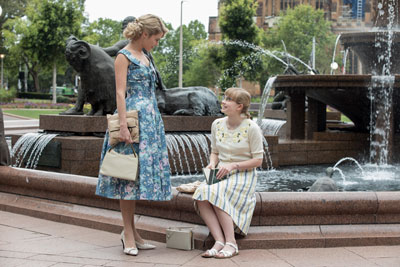 "Angourie is extraordinary," says the director. "She was very quiet and shy when I first met her, but when you see her on film, she has a magic. The camera loves her, and she plays with a tremendous amount of insight and subtlety. I think she's remarkable."
"Angourie is extraordinary," says the director. "She was very quiet and shy when I first met her, but when you see her on film, she has a magic. The camera loves her, and she plays with a tremendous amount of insight and subtlety. I think she's remarkable." For Sue Milliken: "I've never seen anybody with that amount of talent at that time in their career. Sometimes I would burst out laughing, watching Angourie on set. She has a comic timing and yet also a sweetness and a vulnerability as well."
"Having someone as talented and unique as Angourie at the start of her career, but already with so many fantastic credits, was wonderful," adds Zitserman. "She's an extraordinary actress with incredible talent. She already has an enviable CV, but I think we'll be seeing a great deal of Angourie Rice in cinema."
Rice herself says of the script: "I thought it was brilliant, so nuanced and a great ensemble piece. I was drawn to Lisa and her amazing journey. For this journey to happen, you need somewhere for her to begin. She's shy and doesn't feel like she fits in anywhere; not with her family, not at Goode's. From that starting point, Lisa becomes confident and unapologetic for who she is. She comes to truly believe in herself."
When Lisa meets Michael, the son of Hungarian immigrants, who has also just finished his Leaving Certificate, a delicate, tentative romantic attachment begins.
Rice intimately related to Lisa's love of words and books, and her dedication to the growth of her mind. "Education is so important for Lisa because it opens the door to a world of opportunities. The film sends a great message that education is important for everyone, no matter who you are. Education is vital to how the world progresses."
"Part of Lisa's education is to learn to embrace that people are different, and to appreciate what their uniqueness contributes to the world. This is an issue we still struggle with today.
The small corner of the world that we each live in is not the only one. It's fantastic that that story is being told to audiences today."
Of working with Beresford, Rice says: "As a young actor, it was fantastic to be able to work with Bruce Beresford. He would say, 'Overlap it. Improvise. Make it sound as natural as possible.' He helped me create the illusion that Lisa was hearing everything for the first time, and saying everything for the first time. He was always calm on set; having a calm director and producers made the whole set relaxed but also focused."
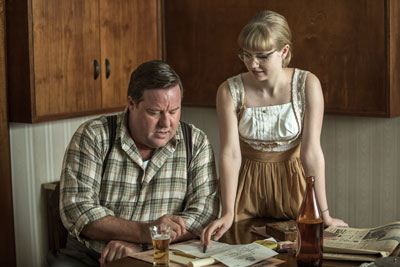 Magda Szombatheli – Portrayed By Julia Ormond
Magda Szombatheli – Portrayed By Julia OrmondMagda is a Slovenian immigrant who, on arriving in Australia, lived in a refugee camp in Lithgow, NSW. Strong-willed and prickly, Magda has stridently bettered her situation, securing the enviable position of running the Model Gowns section at Goode's, which she does at a distance from the other ladies in black, who she seems to look down on from her rarefied area of the 5th floor.
"Magda has told Goode's that she worked in fashion in Paris before WW2, which is probably not true," observes Bruce Beresford, "but she had some connection with the fashion world back in Slovenia and she has good taste in clothes. She's rather imperious, but also we come to find out, very kind."
He continues: "Magda went through hell during the war. The Nazis took over Slovenia, and when they left the Communists took over, who did things like ban Vogue magazine, which Magda thought was the end. She couldn't work in a society where everything was collectivised; she was too much of an individual. She could have gone to America or to England but she chose to come to Australia, about which she knew nothing."
For Allanah Zitserman: "Magda sees Australia as freedom, as the place that saved her. She knows what the world can be like and here is the sun and beaches. She appreciates the Australian way, but brings an entirely different perspective and view. It's fascinating seeing those two cultures collide at first, and then merge."
One day while shooting another project in Toronto, Beresford was going through lists for possible actresses for Magda and suddenly thought of English actress Julia Ormond and her commanding presence; what Beresford calls "a gracefulness tied with a firmness". The script was dispatched and Ormond responded positively almost immediately, as she related to Magda on a number of levels.
"What I most liked about the script was that it was set in 1959 in Australia, but seemed to tap into a lot of themes that we're globally dealing with today, like how we approach cultural differences with refugees and migrants so that people are assimilated in a way that's healthy," says the actress.
"I've known a number of Eastern European women, as well as costume designers and fashion designers. I worked in a shop when I was a kid, so I knew about that environment. Also, one of the wonderful things as an actress is that there aren't the usual hierarchical lines between generations, so there have been many women who took me under their wing, like Magda does with Lisa. So, I felt like there was a great deal in Magda that I knew, and I liked the tone of the script " a lightness but with enough anchoring moments so that it was moving as well."
Of Magda's complex personality, Ormond notes: "I wanted there to be the moments in which the audience could perceive her as uptight, but as you get to know her, you form an understanding of her slight defensiveness. As a migrant, how she's been treated has been isolating. She's fairly uncompromising, and there's definitely something about us Europeans where our sense of humour is different. We can come across as brusque. She's not sentimental as a character. She just is who she is."
Magda sees in Lisa some of her own attributes. She wants to ensure that her protégé takes advantage of the opportunities she herself never had.
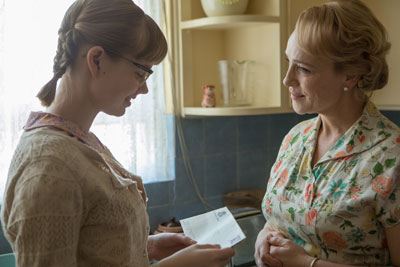 Julia Ormond explains: "What Magda sees in Lisa is that she's young, very clever and has depth. From the moment Magda sees Lisa, she sees that she picks up on things very quickly." The closeness with Lisa, almost as though she's a younger sister, is emblematic of the way that Magda embraces the people she trusts – her husband Stefan and her fellow European immigrant friends.
Julia Ormond explains: "What Magda sees in Lisa is that she's young, very clever and has depth. From the moment Magda sees Lisa, she sees that she picks up on things very quickly." The closeness with Lisa, almost as though she's a younger sister, is emblematic of the way that Magda embraces the people she trusts – her husband Stefan and her fellow European immigrant friends. "For the communities who came through the camps, there's so much past that they left behind, that friends are family, and people like Lisa who are brought in become family," explains Ormond. "There's a fear around acknowledging that they're happy. It's dancing on a delicate line " can we give ourselves the licence to be happy; does that mean it's all going to go wrong again?"
Beresford, Ormond and Angourie Rice worked extensively together during pre-production to analyse the deep relationship between Magda and Lisa.
"The first time I saw Julia as Magda she was wearing tortoise shell cat's eye sunglasses, a leopard print silk scarf around her hair, red lipstick and beautiful long red nails, and I thought, 'Oh my gosh, that's Magda. That's who she is,'" says Rice. "Julia emulated sophistication and style and it was amazing to be around her and to watch her work, and to work with her."
"Angourie is very, very special," Ormond responds. "She was beyond perfect for this role. Everything flows very easily from her. It always feels very present. She's sweet and youthful and you can't take the intelligence out of the eyes. She's clearly got everything at her disposal that Bruce would have wanted for Lisa. She's very talented."
Of working with Beresford, Ormond says: "Bruce was great, very generous. There was a lot that we played with. I love doing work that's detailed and that anchors the film in the actual world of the people. Shooting on location always has its challenges, but the strength of the relationship got us through them."
Fay Baines – Portrayed By Rachael Taylor
Fay comes from a conventional Australian background, and was a nightclub dancer until, unhappy with that world, she moved into a sales position at Goode's, in Ladies' Cocktails. Disappointed with the men she meets with her old dancing friend Myra, Fay has a depth that even she herself is only subtly aware of at the beginning of the film.
The Australian actress Rachael Taylor, who portrays Fay, says: "She's an optimistic character on the surface, but underneath she has a complexity, and I was excited by the challenge of how to marry those two layers. Fay has a deep yearning for more."
Bruce Beresford had not seen Rachael Taylor act on film, "but Christine King put forward her name, so I looked at some of her work and said, 'You're absolutely right'. We got in touch with her and it went from there. Rachael has that wonderful knack that really great actors have of making the dialogue sound as if it's improvised."
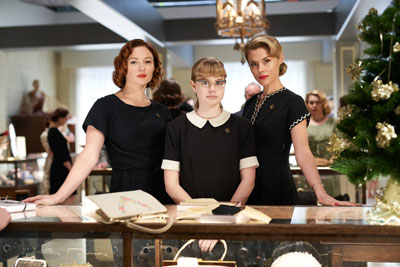 Because Fay had to leave school at fourteen after her father was killed in WW2, she's never had the opportunity to discover her intellect.
Because Fay had to leave school at fourteen after her father was killed in WW2, she's never had the opportunity to discover her intellect. "The story is a beautiful rendering of how the issues these women were facing still relate to being a woman today," Taylor says. "For me it's about female desire and female selfactualisation; about what women want, how they have to contort themselves to achieve what they want, and about how these women slowly stop doing that."
"We see New Year's Eve 1960 in the film, and it's a moment in which some of the restrictions that women live under start to crack and break apart. The fact that these women start asserting themselves and taking up more space in the world was very exciting for me."
After her initial hesitation, Fay becomes more friendly towards Lisa, leading to the trigger for Fay's transformation " Lisa handing her a copy of Tolstoy's great romantic, tragic novel Anna Karenina.
The emotional impact of the book creates a landscape in which, when Fay is matched with RUDI, a Hungarian friend of Magda and Stefan's, his savoir faire and cultured personality charm her. Fay becomes more open-minded to this 'reffo', and falls in love.
Rachael Taylor found working with Angourie Rice "an absolute dream, she's such a talented actress. As soon as I saw her walk onto the Goode's set, I thought, yes, that's the character, that's Lisa. She's so generous and wise beyond her years. She's an extraordinary actress and I feel so lucky to have worked with her."
For Taylor, working with Beresford: "was a career highlight. He has such an incredibly insightful understanding of character, more than anyone I've ever worked with. All his films have an incredible amount of detail, in a way that somehow also feels completely natural. As a director he understands actors so well, in such a thorough way."
Patty Williams – Portrayed By Alison Mcgirr
Patty doesn't warm to Lisa at the same time that Fay does. Patty is often troubled and irritable, chiefly caused by concerns she has about her husband Frank, a painfully shy country boy. Patty desperately wants to have a baby, but Frank, a tiler, is always exhausted, and is inattentive to his wife.
"The question that Patty's story raises is 'what is a woman's role in the bedroom?'" observes Allanah Zitserman. "How open can she be about her sexuality? That's the underpinning issue that she has with her husband and their relationship, so there's a wonderful story of her coming of age in the bedroom, so to speak."
Actress Alison Mcgirr, who was cast as Patty, was immediately drawn to the idea of Ladies In Black when it was introduced by her manager.
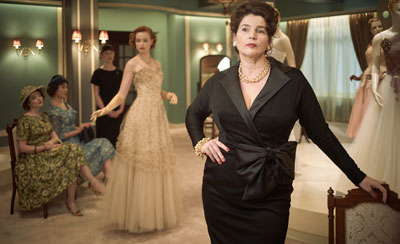 "The draw card of working with Bruce Beresford, the beautiful setting, and working with actors like Rachael, Julia and Angourie " it was a dream come true," McGirr says. "The script was beautifully written and addressed its issues in a subtle way, but still had a strong message."
"The draw card of working with Bruce Beresford, the beautiful setting, and working with actors like Rachael, Julia and Angourie " it was a dream come true," McGirr says. "The script was beautifully written and addressed its issues in a subtle way, but still had a strong message." Bruce Beresford spent some time looking for Patty, as: "Whoever was going to play her had a tricky task, because she had to play a woman who's bitter and angry. We auditioned an enormous number of young women, and I kept looking at the tapes feeling that none quite captured it, and then one turned up at the last minute. Alison had sent a tape that she'd done herself, and I looked at it and thought, 'That's it. That's exactly who the character is.' I said, 'We've got to get this girl' and we did, and I was delighted with her."
McGirr's parents emigrated to Australia in the 1970s during The Troubles in Northern Ireland, so the struggle of integration and acceptance was powerful for her.
"My parents faced a lot of discrimination, my dad in particular," McGirr says, "so I felt connected to that side of the story. Ladies In Black shines a light on the fact that we need to learn how to welcome the change that these amazing, different cultures will bring, rather than to be afraid of them."
Patty commiserates with Fay's men problems, but doesn't share a lot about her own relationship issues. There's a sense of casual superiority about Magda that rubs Patty up the wrong way, and Lisa's easy youth frustrates her, but as the story progresses, all three women inspire change in Patty.
"Lisa instils a sense of hope and drive in Patty," says McGirr. "Patty sees this young girl going after what she wants. She sees Fay falling in love, and that's infectious. In Magda, Patty eventually sees a strong woman who has gone through a lot, but she's running her own life. These positive influences inspire her."
Miss Cartwright – Portrayed By Noni Hazlehurst
Miss Cartwright has worked at Goode's for countless years, and is now the floor supervisor for Ladies' Cocktail and Model Gowns, where she cuts a rather forbidding figure alongside fashion department floor walker Mr Ryder. For both, their identities are defined by their uniforms. Other workers come and go, but they keep Goode's on an even keel. "Madeline St John was creating a clever framework by arranging these women of different generations and experiences together," observes Sue Milliken. "Miss Cartwright didn't have the opportunities that Lisa's going to have in terms of education. She's in a position of considerable authority, but her life is at Goode's. We don't really understand her until, in a brief scene, we see what her family life is."
Noni Hazlehurst, who was cast as Miss Cartwright, had first worked with Bruce Beresford in 1977, in a small role in The Getting Of Wisdom.
"Noni's one of the best actresses in Australia, probably one of the best actresses there is," says Beresford. "Sue contacted me while I was in Canada and said, 'What about Noni to play Miss Cartwright?' and I said, 'It's a fabulous idea. Would she do it for us?' Noni is amazingly cooperative and brought so much insight to every scene. Every time she played a scene I thought, 'Gosh, that's a lot better than I thought it could be.'"
"The restrictions that women suffered in the 1950s are why people like Germaine Greer and Betty Friedan started to think and write and have an effect," says Hazlehurst.
"Miss Cartwright is a spinster " that horrible word. Had she been married and had children she wouldn't have been able to keep working, in this period of women being restricted and pigeonholed. You can be a shop assistant, you can be a wife, or you can be a mother. Lisa's coming of age in Ladies In Black is a metaphor for how women are going to grow and expand into the 60s and 70s and beyond."
Miss Cartwright runs a tight ship, but there's an empathetic side to her, a kind streak. When she looks at Lisa, Miss Cartwright feels regret and pain at what she has missed in life, but in the end she recognises the potential in this young woman, and in a memorable and moving speech, spurs Lisa on towards her future.
"Although at first she appears intimidating to Lisa," says Hazlehurst, "Miss Cartwright recognises that this is a girl with great potential, and although Miss Cartwright could never develop her own potential, she encourages Lisa to embrace and realise hers."
Of working with Beresford again, 40 years after their first film, Hazlehurst says: "Bruce is a very gentle man, and knowing that it took him so long to make this film reassured me that it's a heartfelt project for him. It's not just this year's movie. I think his wanting to try to capture this period in Sydney so faithfully and truthfully, and to tell this story of these women says something about the man, and that is reflected in his manner on set. He is a very gentle man who can communicate with humour."
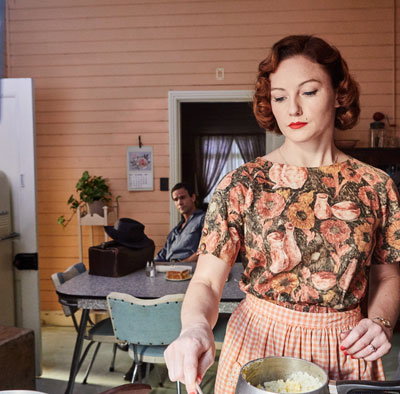 The Parents
The ParentsMrs. And Mr. Miles – Portrayed By Susie Porter & Shane Jacobson
Mr. And Mrs. Miles are a particular type of 1950s suburban couple. Mr Miles is a linotype operator at the Sydney Morning Herald, who works the night shift for the morning edition, then sleeps during the day and gambles on weekends. Mrs Miles is a housewife who makes all of Lisa's dresses.
"Mr. Miles has very conventional views about education, and this was the thing that spoke to me when I read the book, because my parents were the same," explains Beresford.
"When I said that I wanted to go to university, my mother said to me, 'No-one in the family's ever been to university,' and my father said, 'What do they do there?' Lisa's father can't really see the point in a girl getting this kind of education. It was a view that was very common at the time."
Mr. Miles loves Lisa but he doesn't show it. With her mother, she's extremely close, almost like best friends. They share a secret language that Mr. Miles is oblivious to, in order to work around his stubbornness.
"Her mother's very caring and supportive of Lisa," observes Angourie Rice, "but in Mrs. Miles' eyes Lisa is still a 10-year-old kid. Lisa opens their eyes to a new world and says, 'I will go to university, and I want to be called Lisa.' As she becomes more confident, her parents also grow with her."
Mr. Miles represents the intractability of a type of Australian man at the time; stuck in their ways, and challenged by change and difference.
"There was only one income and that was enough to live a comfortable life on," explains Sue Milliken. "One of the subtleties of Madeline's book is that Mr. Miles works in a place of education, a newspaper, but has no interest in education himself. Mrs. Miles probably feels that she might have had another life, but doesn't really mind because they 'knock along together alright' and they have this beautiful child who holds them together."
SHANE JACOBSON, who plays Mr. Miles, says: "He's indicative of the late 1950s. He's a loving father in a time when not all fathers were great at showing their affection. They were very guarded. The concept of his daughter going to university also challenges him; girls don't work, they find a man, they get married, and they make a home. It's a foreign feeling to me, but as actors our job is to jump into a character and represent their time."
Susie Porter, who portrays Mrs. Miles, had first heard of the book and the idea for the film 20 years ago, when she first worked with Bruce on Paradise Road.
"Bruce talked about a novel, The Women in Black, that his friend had written, and that he would love to make a movie. And now, here I am," Porter observes.
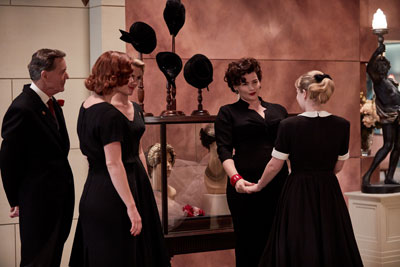 "Back then I would have auditioned for one of the younger characters, but I wanted to work with Bruce again, I've always respected his movies, and then reading the novel, I thought it was such a beautiful coming of age tale."
"Back then I would have auditioned for one of the younger characters, but I wanted to work with Bruce again, I've always respected his movies, and then reading the novel, I thought it was such a beautiful coming of age tale." Susie Porter sees Mrs. Miles as "a loveable mother. She's married to someone who spends a lot of time gambling and working nights, so her life is her daughter. She lives vicariously through Lisa. Mrs Miles would have left school at 15 or 16, she wouldn't have entertained the thought of a career, especially not a poet or an academic or an actor. It's all about her daughter having the best future she can, the kind of future that she wasn't able to have."
"It's important to this story that I'm the stereotypical housewife, because that was a reality of the day. Women are still not completely equal, but we're getting there. We can have a career, choose to have families later if we choose to have them, marry later if we choose to marry. My Mum had four daughters at the age of 28, and then never really went back to work. Lisa represents the beginning of women becoming educated, really."
The way in which the two women join forces to achieve the goal of Lisa's education is amusing and also touching, as is Mr. Miles' eventual embracing of the idea of a university education for his daughter.
"Mr. Miles' journey is profound because he's set in his ways, but change is inevitable," observes Allanah Zitserman. "I think that's what Ladies In Black is so clever in doing; it highlights that change is inevitable and that one should embrace it. That story line is across each of the plots, in the journeys of all of the characters."
Of working with Beresford, Shane Jacobson says: "There are different ways that people lead. Some demand things, and others do things gently and are the kind of people you'd go over a wall for. Bruce is the latter. You want to do a great job for him. He knows what he wants, he's a wonderful director, but he's also a wonderful human being. I think that's why people want to work with him, and it's definitely why you give your best performance, because there's a calm feeling on set. He truly is one of a kind, and I was honoured and privileged to be a part of this film."
Of working with Angourie Rice, Susie Porter says: "I look at Angourie, who is so together and so mature for her age, and I'm amazed by her. Her wisdom and maturity are incredible. She's such a lovely actress, and I couldn't imagine anyone else playing Lisa, I really couldn't. She was perfect."
Shane Jacobson adds: "Angourie Rice is an amazing young actress. She's already enjoying an incredible career. She will dominate screens for a very long time I think, and for good reason. She's a fantastic kid that is completely unaffected by fame, and that can be quite rare for someone her age, with the amount that she's achieved at a very young age. I hope she's proud."
The Men
Rudi Janosi – Portrayed By Ryan Corr
Rudi, a friend of Stefan's, is a young, debonair man, highly cultured, but anxious to understand the Australian psyche and to make his way in this new and strange place. As part of the process of integration, he's looking for an Australian girlfriend, and so Magda arranges for him to meet Fay.
Bruce Beresford says: "Rudi speaks four or five languages, he's much more courteous than the Australian men that Fay has been meeting; Rudi takes her to dinner, he's polite and refined and doesn't jump all over her, and she responds immediately to the continental charm." There is a suggestion however that Rudi may be up to no good, which was important to the way the story plays out.
Ryan Corr, who portrays Rudi, says: "Bruce said to me from the outset, 'right up until the end of this film, I don't want to know what's going to happen, whether we can really trust Rudi.'"
"Fay has a strength and a salt of the earth quality that Rudi is drawn to, and he's been through a dark past and is now moving forward. She respects him and wants to be around his ambition. In the end, Fay discovers that he is a very nice man who is not just trying to get her into bed, but is starting to fall in love with her. It's a very tender romance."
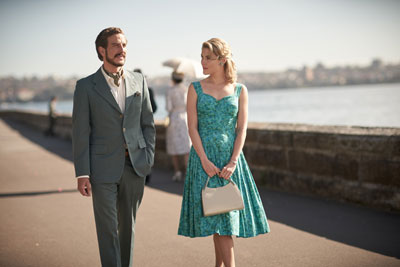 Rachael Taylor, who plays Fay, adds: "Initially, Rudi is perhaps not the kind of man Fay thinks she wants; she's cautious about this stranger, from what she sees as a very different background, but the barriers are slowly broken down. Her appetite is for someone new, for something more, and Rudi really speaks to that."
Rachael Taylor, who plays Fay, adds: "Initially, Rudi is perhaps not the kind of man Fay thinks she wants; she's cautious about this stranger, from what she sees as a very different background, but the barriers are slowly broken down. Her appetite is for someone new, for something more, and Rudi really speaks to that." Corr had known of Ladies in Black as a musical, but wasn't aware that it was adapted from a book when he was invited to audition for the role.
"I did a couple of auditions using my initial Hungarian accent, which was at that time a horrible amalgamation of German and Swiss accents, but I think I understood the energy of Rudi," says Corr.
"Bruce has a very detailed casting process, expertly finding an energy in an individual that matches the character, so that when you walk onto his set, the characters have been cast perfectly. He told me that he's never been on someone else's set. He's never seen another director direct, and so you're welcomed into Bruce's way of making a film. He facilitates an environment where everyone can be as good as they can at their job, where everyone is able to flourish and relax. I'd never seen so many smiles on a film set."
Beresford was immediately impressed. "Ryan had studied the accent, and by the time I met him he could do it flawlessly. He's got a lot of personality, which the role needed. I felt that unless Rudi came across as having a lot of charm, the whole film was going to collapse. It was crucial to get someone who could do it that way, and he does do it."
Of working with Angourie Rice, Corr adds: "Angourie was going off to do a Year 12 German examination in between scenes, and took it all completely in her stride. It was a reminder of where ambition and where talent starts. She's an exceptional young performer. I was astounded by her and by her work, she is wise beyond her years."
Stefan Szombatheli – Portrayed By Vincent Perez
Swiss actor Vincent Perez has known Bruce Beresford since working together on the film Bride Of The Wind many years ago in Europe. When casting lists were being put together for Ladies In Black, the director called Milliken and Zitserman and talked to them about Perez and his "likeability and effortless amiability".
"I was in London and I called Vincent and said; 'I'm coming over to see you. I've got a film and you have to be in it.' Vincent replied, 'I'll do it. I'll do it. I'd love to come to Australia and make a film with you.' I was so glad, as he's a really brilliant actor."
The character Beresford had earmarked for Perez was Stefan, Magda's husband, a Hungarian who had fled the 1956 Revolution, and who she'd met in a refugee camp. Stefan, like Magda, has a deep appreciation of his new life. He's a successful accountant, and the couple live in an airy apartment looking onto Sydney Harbour.
Vincent Perez says: "Bruce is a wonderful director, and when I read the script, I loved the themes, the atmosphere, the humour. It was beautifully written, and Stefan would be a fun part to play. I'd made a few movies in Hungary, and I wanted to bring a sense of the way I see Hungarians biting into life and enjoying the moment. Stefan and Magda are very different to one another, but they went through very difficult challenges. They both know what's important, and what's secondary. That's what brought them together."
Like other cast and crew members, Perez connected very personally to the subject matter. "My parents came from Spain and from Germany, they emigrated to Switzerland and I was born there, so I could connect to Stefan on that level. The film looks at the issue in a very positive way, which I think we need. It's very important to show that side, not only the difficult side, but how society can be enriched with foreign people coming in, bringing their knowledge and their culture."
The relationship between Magda and Stefan is distinctly different to that between Mrs. and Mr. Miles. Stefan does the cooking, he's gracious to his wife, and he's emotionally open and supportive. The relationship shows Lisa that there are more nurturing dynamics in relationships between men and women. When Magda decides to open her own boutique at the end of the film, her husband stridently supports her.
Julia Ormond says: "Magda and Stefan have each other's backs. She doesn't speak Hungarian and he doesn't speak Slovenian, so they speak English, which is odd for them, but they have a very solid relationship because of the history that they've shared and the life that they're making."
"Vincent was wonderful, very generous," she continues. "When you have films with a lot of female characters, there's something very confident about the men who step into the male support roles, and Vincent embodied all of that. He has a natural ease being cultivated and sophisticated, but not heavy-handed with it."
Perez says of Ormond: "Julia is an incredible actress. She created an amazing character in Magda; she really transformed herself. I could hardly recognise Julia. She's wonderful to work with, very precise and extremely involved."
Of working with his friend Beresford again, Perez says: "Bruce has made 35 films and he still has the same flame. The great ones all have that. We have a beautiful relationship personally, the fact that we have remained friends through the years meant that we didn't need to speak much on set, we just filmed. One of Bruce's main talents is that he trusts his casting. He knows when he brings an actor in that yes you can change a few things here and there, but the casting is crucial, and so a great deal of work is done."
Frank Williams – Portrayed By Luke Pegler
Frank, a country boy, grew up in the bush and speaks only when absolutely necessary. He's painfully shy, and it's difficult for him to tell his wife Patty how he really feels about her, let alone about anything else.
Young Australian actor Luke Pegler, who portrays Frank, recalls: "I read the script, and knew immediately that this was a very special film and role. It was the character I was drawn to. I think that the most beautiful thing about Frank is that he's completely misunderstood for three quarters of the film."
"After their night of passion, Frank feels as though he's taken advantage of Patty, so he gives her a couple of weeks space, assuming that she won't want to be around him, but when he comes back sheepishly, he discovers he was greatly mistaken. He's nervous and an awful communicator so that when the truth does come out, it's a beautiful thing."
Pegler grew up in Perth with Italian-Australian neighbours on all three sides of his family home. "The family on our right kept chickens and we'd get fresh eggs every day," he recalls. "The neighbours on our left would make their own prosciutto and sausages, and we went over for an early dinner every night before coming home and watching Home and Away with Mum and Dad and have a second dinner, probably not quite as spectacular. So, I was part of a generation that didn't feel that there was any gap, any frictions, but now there is another wave of people having to deal with the issues post-war immigrants had, so the film's exploration of these issues is incredibly current."
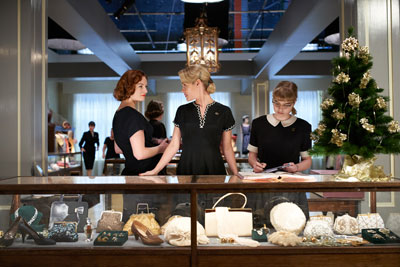 The Production Locations
The Production LocationsLadies In Black was filmed in and around Sydney, with exterior locations calling for city and suburban streets, Hyde Park and the Blue Mountains, as well as many interior locations " a Kings Cross nightclub, a café, a harbour-side apartment, several suburban homes and even the famous department store upon which the book is said to be based, David Jones.
This film required a lush, detailed and multi-layered approach from all visual departments. "We were very lucky to have Peter James as Director of Photography, who'd worked with Bruce Beresford on seven previous films, including Driving Miss Daisy and Double Jeopardy," says Allanah Zitserman. "They have an inner language; it's almost like they're dancing on set, it's very smooth and the crew feel that."
"The incredibly talented Felicity Abbott did an extraordinary job with the production design; it was a huge film for the art department. Wendy Cork and Jen Lamphee and their teams had to dress, style and make-up 50 characters and extras, and created an incredibly real sense of the characters, each and every one. It was a privilege to be working with these people."
In addition to Create NSW, Destination NSW also came on-board as a production partner. "What excited Destination NSW so much about Ladies In Black is that it presents so many of the divine aspects of the city within a broader story," says Zitserman. "We see the characters in Hyde Park, on a ferry crossing Sydney Harbour, at beaches, in the Blue Mountains, in the inner city, the inner west…all the places that make Sydney such a unique city."
Sue Milliken adds: "The Blue Mountains City Council were also wonderfully helpful, so we were very grateful to all of them " Create NSW, Destination NSW and the Blue Mountains City Council all supported the film. We were very lucky to have them all as partners."
Production Design
Production Designer Felicity Abbott was working on the Benjamin Britten opera Albert Herring, which Bruce Beresford was directing in Brisbane, when he approached her about Ladies In Black.
"I was so excited as I'd read the novel, and we started talking about Bruce's knowledge of the author and that period," recalls Abbott. "I started researching immediately. Even though the film hadn't been fully financed, Bruce said to me, 'if it does get fully financed, then I'll ask you to design it.' He kept his promise."
Beresford has created many period films, and given the setting of the Britten opera was the year 1900, Abbott knew how particular his attention to detail was for period settings.
"He likes what I would call a stylised form of naturalism," Abbott says. "It was very important to Bruce that we would have real products on the set, for example. We went to a lot of trouble to clear brands like Vegemite, Weetbix and alcohol brands of the era, in an effort to create that layer of naturalism. Bruce was very insistent about it."
The palette for Ladies In Black was inspired by the work of haute couture designers and high-end department stores of the period. Beresford and Abbott discussed some European films, but also two American films released in 2015; John Crowley's Brooklyn and Todd Haynes' Carol, both set in part in 1950s department stores.
Goode's is its own character in Ladies In Black. Although it's never made explicit, a scene in St John's book " in which staff members exit the staff door and cross the road to St James Station " identifies it as David Jones on Elizabeth Street, Sydney.
"I believe Madeline St John had a holiday job there," states Beresford. "She told me she didn't, but people who worked there have said that her depiction is so accurate in its details, that unless she worked there she wouldn't have known those things."
Most scenes set in Goode's take place in the fashion department on the 5th floor, for which the art department and construction department built a large set at Fox Studios, Sydney. However, briefly establishing the extravagant ground floor of the stores was vital.
David Jones on Elizabeth Street has of course been modernised since 1959, but by an incredibly fortuitous coincidence, the 7th floor of the building had not been used as a trading floor some time, however it was about to be renovated as part of the store's multi-milliondollar redevelopment. The producers successfully secured approval from David Jones' management to film on the floor on one day " the day before the refurbishment commenced.
"The timing was one of those things about this film which made me think we were blessed," says Sue Milliken. "David Jones held the builders over for a weekend so that we were able to go in for one day and film the sequences set on the ground floor. It was a masterpiece of organisation for our production team under production manager Anna Steel, for Peter James and his crew in terms of lighting, and for Felicity Abbott and her team to dress the floor to pass for the ground floor of Goode's. With all that, we would never have got through the day without a director of Bruce's ability and experience. He was very cool, and even managed a joke or two to keep everyone from having a nervous breakdown under the pressure of getting everything shot."
"We installed a false wall so that extras would enter as if coming in from the street, we put a grand piano in and a fountain as there would have been on the ground floor," says Abbott. "We found a couple of beautiful historic cabinets in the David Jones store rooms, then sourced the mannequins, rebuilt the plinths, all the cabinetry, all the displays, and then sourced all the stock. It took a lot of dedicated time to find the right handbags, gloves, haberdashery and hats to fill the ground floor section."
For the 5th floor set at Fox Studios, Abbott and her team looked at many archival images of the period supplied by David Jones, as well as of other global high-end department stores, which generally shared a similar approach of being clean lined and uncluttered, with an emphasis on elegant presentation.
The producers worked with the Human Resources department of David Jones, and offered David Jones staff the opportunity to be extras in the film.
"It was such a wonderful experience," says Zitserman. "One of the extras had been at David Jones for three decades, and had been an immigrant. She'd experienced a lot of what is captured in the story. When moments like that come about, it enriches the partnership but also the experiences of the individuals involved. It was a terrific opportunity between David Jones and the film."
Sue Milliken adds: "When we started making this film we found that everyone has a David Jones story. So even though it's not called David Jones in the book or the film, the ethos of David Jones and its tradition in Australian life were important. When I was a child growing up in the country in the forties and fifties, we would excitedly receive the David Jones catalogue every three months, which had little squares of real fabric attached to it for placing mail orders. So that's my David Jones story! The store has been an institution in Australian life for so long, it was wonderful to have the connection."
For the actors portraying the ladies in black, the level of detail demanded by Beresford and achieved by Abbott and her team provided a great support to the actors in crafting their characterisations.
"Every time I stepped onto the set, I was in Lisa's world," says Angourie Rice. "I didn't have to imagine it. Half of my job was done for me. I decided that the first time I walked into Model Gowns should be right before we did the scene. Lisa has seen Magda walking in there, and seen the models coming out wearing elegant gowns, so it was an amazing experience. The incredible work the art department had done enabled me and the camera to capture the impact of that moment for the character."
Noni Hazlehurst says: "I was born in 1953, so I remember going to these sorts of shops with my mother in her hat, gloves and pearls. The formality, the elegance of the women who worked there and the details were magnificent, and all recreated by the art department. I could all but smell the perfume. We were so lucky to have this support as actors."
The old Mark Foy's Department Store, now a law court inside but with a preserved historic exterior, was used to visually establish Goode's Department Store. Create NSW helped the producers secure permissions and solve the complications of stopping traffic in a busy city on a Saturday, to enable the crew to create the 1959 set scene.
Repin's, a chain of Sydney cafés active between the 1930s and the 1960s, offered customers premium coffee made in good coffee machines introduced by Europeans, and were frequented by a young Bruce Beresford during his university days.
"Bruce wanted to recreate a Repins café for a key scene," says Abbott. "We filmed at the Paragon Café, a famous art deco café in the Blue Mountains with wooden booths, which is reminiscent of Repins. We secured permission from the Repins Estate to reproduce the coffee cups, plates, saucers and menus. The Powerhouse and the State Library of NSW hold quite a few references to what the menus looked like, the signage, the displays, the cups and saucers, so we reproduced those elements for the film. It made Bruce very happy!
"We were able to acknowledge the Paragon café when Rudi gives Lisa a box of Paragon chocolates for passing her exams."
A small but crucial scene, which presented yet another challenge for Abbott, required recreating part of a Sydney Morning Herald printing press, the type of printing press no longer functional anywhere in Australia.
"The Sydney Morning Herald scene was the scene you read in a script as the designer and think, 'how on earth am I going to do that?' says Abbott. "I got on the Internet, as you do, and discovered that there was a print museum in Penrith staffed by retired gentlemen who had restored and renovated linotype machines from the period, and who were all former Sydney Morning Herald linotype operators. I drove Bruce out to meet these gentlemen, and he was so enchanted that he rewrote the scene and set it in the pre-press section, and used all the men as extras in the scene."
For the Miles house, Abbott and Location Manager Jeremy Peek found an original 1950s red brick house in Strathfield, Sydney, which had survived modernisation. The carpets, textiles and art deco bathroom were all intact.
Shane Jacobson, who portrays Mr. Miles, says: "The house was very similar to the houses of my grandmothers, aunties and uncles. When I first walked into the home, dressed by the art department, I said, 'I went to Christmas parties, birthday parties, and, dare I say it, to wakes in houses exactly like this!' It gave me a warm feeling in a strange way."
Beresford, Abbott and the producers were grateful that there are so many people dedicated to preserving the past, who made the depiction of the world of Ladies In Black possible. "We found original trams that we were able to film, old buses… there are wonderful people who are carefully maintaining them, who are passionate about history," says Zitserman.
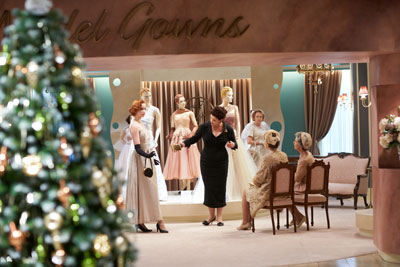 Costumes
CostumesCostume Designer Wendy Cork, like Felicity Abbott, was working with Bruce Beresford on the opera Albert Herring, when the director took Cork for coffee and posed the question if she'd be interested in working on Ladies In Black.
"I was thrilled to be asked," says Cork. "I was given the script 6 months after the first offer from Bruce, and after I'd read the script, I read the book. I didn't want to be influenced by the book; I first wanted to see what the screenwriters had drawn from it."
Initial discussions between Beresford and Cork about the broad approach to costuming focused on finding a fresh authenticity for the period and for the characters.
"Bruce didn't want to see the look that has been made popular; the very nipped in waists and the very big skirts. Bruce wanted the reality of the period rather than a swing set reinterpretation," says Cork.
"We chose a very muted colour palette, which wouldn't overpower the characters. A lot of Bruce's work is very character-based and he wants to show the reality of these people, so that's where he feels the costumes should come from; that they help tell that story."
Cork looked to fashion photographers of the time, including the Americans Irving Penn and Richard Avedon, as well as to the iconic models of the 1950s, such as Suzy Parker and the house models that worked for Dior.
"The Dior shape was important," says Cork, "because it became very important in Australia. A lot of women could go to David Jones to actually have a licensed Dior made for them."
For the character of Lisa, her transformation through clothing was a crucial process to convey, both for the actress Angourie Rice and for the costumes that Wendy Cork and her team would produce.
"The handmade clothes that Mrs. Miles makes for Lisa are practical cotton dresses, there's no embellishment on her until she meets Magda," explains Cork, "there's no sense of ownership of her own clothes until Magda shows her how to bring out the Lisa who is within her. Magda teaches her that what you wear can reveal your personality."
Rachael Taylor adds: "One of the things about fashion is that it's easy to relegate it to the category of frivolous, but it really isn't. In Ladies In Black, the clothes are about how women declare themselves to the world and how they declare themselves to each other; how they dress for the life they have and dress for the life they want."
Cork distinguished the individual ladies in black very specifically.
"Magda is 'recreating' a past and a present that is actually her creation. She has a very confident, womanly shape. She's prepared to stand out boldly in gold jewellery and beautiful black figure hugging dresses that are incredibly sexy. She's a woman who owns her own self, who is telling her own story."
"Fay was a dancer, and is used to the attention of men, but not in a particularly empowering way. She's at a point in her life where she wants to find herself as herself, so her journey is going from exposing her body to discovering her own femininity and playfulness. Patty's journey is about re-establishing the intimacy that has gone from her marriage. In 1959, people weren't allowed to enjoy their bodies yet. Patty exposes herself beautifully in her underwear to the girls at work when she's changing, to the doctor when she's going for a medical, but never in front of her husband. The one moment that she does, it re-ignites their passion for each other."
At the opening of the film, Lisa's black dress is too big for her. It's plain and she looks small and fragile in it. As the film progresses, she decides to add a little belt, and a little bow. "We tell Lisa's story through the dialogue and the action," comments Rice, "but also through what she wears and how she holds herself, and how those aspects develop through the film." Cork kept Miss Cartwright in post-war grey, and in a sharply tailored structure.
"Miss Cartwright has one suit, and a series of dicky front shirts. She's the one who wears regulation jewellery; her pearl necklace and pearl brooch. Magda will wear whatever she wants, but for Miss Cartwright the symbols of her job are very important to her, because outside that she has very little else. I didn't want to make her too severe though, so her jacket has a soft lavender colour and a soft shape to the collar."
Of the Costume Designer's work, producer Allanah Zitserman says: "Wendy Cork really seemed to understand each character and the nuances about them. The costume department had a ball on this film. The world of Ladies In Black is so glamorous, but also quite broad and there are so many women of different types and of different ages. It was a big challenge, but an exciting one."
The male actors also felt the nuance and support for their characterisations that the costume department created. Rudi was clad stylishly in neat fitting suits, pocket kerchiefs and cravats. "I really like the fact that some men of the era put a lot into their appearance," says actor Ryan Corr. "This was a time of beauty and structure in garments. I, as Rudi, am bringing the cravat back and I think I'm going to try to keep a couple of Rudi's suits because they just don't make them like this anymore. Although he isn't rich, Rudi still very much cared about the way he presents himself."
For Magda's Model Gowns section, the producers secured permission from a number of famous fashion houses to use their vintage gowns onscreen, so that when Magda refers to dresses by Dior and Hardy Amies, they were authentic.
Mrs. Miles makes Lisa's clothes, as many mothers did in the era, but a crucial point in Lisa's journey is the moment she sees the 'Lisette' dress in Model Gowns, and desires to be transformed by it.
Wendy Cork went through many different possibilities for the gown, before settling with Beresford and Angourie Rice on the final incarnation. They wanted the Lisette dress to be distinctly un-girlish, to have Lisa aspire to something that isn't frilly, fluffy and pink, but that is elegant and sophisticated.
"I went to many costume fittings for the Lisette dress," says Rice. "Trying on the final version for the first time was amazing. I really felt that Lisa would see this one and choose it, that she would see that the woman who would wear this would be someone who's daring and bold. The skirt was very heavy, made with a beautiful cream silk with sequins which sparkled in the light. It made me hold myself differently, and therefore Lisa held herself differently. I loved the Lisette dress as much as Lisa loves it."
Wendy Cork and her team produced a staggering 1,600 looks in five and a half weeks for Ladies In Black, and with a cast working all over the globe, fittings required complex coordination.
"There were many script days, to tell this story over the period of a summer," she says. "Magda had around 28 looks and Fay had 20 looks"
"We had all the black dresses to create, we had a burlesque scene, Magda's clothes required a lot of drapery, the Lisette dress had handmade rosettes on the back which was half a day's work just on that detail. I had a lot of talent in my cutting room, working long and dedicated hours."
Hair And Makeup
Jen Lamphee was chosen as Key Hair and Makeup Designer for the film, after an initial personal recommendation by Felicity Abbott. Lamphee had worked with Sue Milliken 15 years earlier and hadn't seen her since, but forged a good rapport with the producers in initial meetings.
In the 1950s, post-war and post-Depression, women were embracing makeup and innovative hair styles. Lamphee had a box full of The Australian Women's Weekly magazines dating from 1951 to 1961, which she showed to Beresford to help inform the approach.
"Once I spoke to Bruce about the characters, we did a series of tests and each character slowly came into their own, with different hair and different makeup," says Lamphee. "They each travelled their own unique journey."
Beresford, Lamphee and Director of Photography Peter James wanted the characters' hair to read as authentic, so they avoided wigs and Lamphee and her team cut and styled the actors' real hair.
They also didn't want to make Lisa's journey a clichéd coming-of-age transformation. "It was a fine line, because she's a dowdy teenager who doesn't know her own beauty, but when she becomes a woman, we didn't want to take a 'she takes off the glasses and there's a sexy secretary underneath' approach," Lamphee explains.
"We achieved subtlety by doing the transition slowly from her braids and no make-up, and making sure that the points at which she changes were real. I cut Angourie's hair into a short thick fringe because it brought her into the period and gave us room to grow with her character in subtle ways."
Beresford encouraged Lamphee to consult with each actress, to see how they wanted to develop their character.
"I worked with Julia Ormond to establish the different areas that we wanted to get across for Magda, and to ensure she didn't look matronly," explains Lamphee. "We tried unstructured curls and pulled them all out rather than in too much of a set, which Julia was really happy with and so was Bruce."
"For Fay, I talked to Bruce about how when we first meet her, she wears too much make-up. She's still trying to impress people, and is recalling her dancing days. As she falls in love with Rudi, we see her pare herself back, she gets less and less made up and we see how beautiful she really is, without the mask of makeup."
The actors appreciated the collaborative process, and the way that, as with the costumes and sets, these design elements helped them create their characters.
"The hair and makeup team came up with a beautiful range of looks that flattered where they were meant to flatter, and detracted when they were meant to detract," says Noni Hazlehurst. "For an actor, until you see the costumes and the hair and makeup, you're not really sure what's going to come out of your mouth. It takes a village. We were very fortunate to have world class technicians helping us create these characters."
Producer Allanah Zitserman says: "Jen Lamphee is phenomenal. Her understanding of the range of looks in the period and how women wore their hair and makeup at different times of the day and night was extraordinary. In a period piece, you really push yourself because nothing's easy. You can't just say, 'Oh well, it doesn't matter, we can hide that.' You can't hide anything in a period film."
"The production design by Felicity Abbott, the costumes by Wendy Corr, the hair and makeup by Jen Lamphee and by all of their teams were just beautiful," adds Sue Milliken.
"It was a joy to take visitors on set; they would gasp at the beauty and the verisimilitude. Peter James's cinematography translates the wonderful work of this fantastic group of artists and craftspeople who designed the film. They loved what they were doing because they had an opportunity to do something truly beautiful. What could be more satisfying?"
The Ensemble On Working With Each Other
Julia Ormond on the ensemble: "We had so much fun, all of them were wonderful, Alison McGirr and Noni Hazlehurst, and Rachael Taylor is so stunning, very sweet and down to earth. Ryan Corr was very funny, very spirited. It was a cast that really gelled. Right from the readthrough, it felt like everybody worked really well together."
Vincent Perez on Ryan Corr: "Ryan has a great sense of humour, and brings a rhythm and his own energy into the scene, which was something I could play well with, so the mixture of all that together was wonderful."
Alison McGirr on Rachael Taylor: "Rachael is one of the most generous actresses I've ever worked with. She's beautiful and funny and super talented and I felt so blessed to be standing alongside her, learning, stealing little tips and learning so much of how it is to be. She's effortless."
Rachael Taylor on Julia Ormond: "Julia is amazing. I've been a fan of hers for a very long time so it was lovely to see her arrive as Magda; it's a beautiful character and she's a beautiful actress, it was really a pleasure."
Rachael Taylor on Alison McGirr: "Alison McGirr is amazing, she's an incredible actress. Patty's story is about female desire and about how difficult it was to articulate that in 1959, and Alison is such a beautiful and nuanced actress to bring that to life."
Rachael Taylor on Ryan Corr: "I share my most intimate moments in the film with Ryan Corr and it's impossible not to be a good actor opposite Ryan, he's so engaging and such a beautiful listener. His personality bleeds onto the screen and he made my job very easy. He's very easy to fall in love with, Ryan Corr."
Ryan Corr on Rachael Taylor: "Rachael is a powerhouse, she's incredibly sweet and exceptionally talented. We share a sense of humour, so in the scenes that had to be full of light and secret glances, the ability to make each other smile on and off camera was really valuable. I had an absolute ball working with Rachael."
Angourie Rice on Susie Porter: "I feel so lucky to have been able to work with Susie Porter. She's so caring and loving and played the role so that you could really feel for Mrs. Miles, she's a fantastic actress."
Angourie Rice on Shane Jacobson: "Shane Jacobson is one of the funniest men I've ever met, which was great because Mr. Miles isn't a particularly funny character. He isn't cracking jokes all the time, but Shane makes him sound hilarious. He was fantastic to work with." Shane Jacobson on Susie Porter: "Susie is fantastic, just fantastic, she's an amazing actress, I'd always wanted to work with her, and here was my chance."
Noni Hazlehurst on Rachael Taylor: "Rachael has a lovely energy about her, is very Australian, doesn't bring an ego to the set, just gets on and does it. She really savoured the role; her character is a metaphor for Australia welcoming new kinds of people and opening its eyes to new experiences, and I think she really relished the depth of that role."
Angourie Rice on Rachael Taylor: "Working with Rachael was a delight. She's funny and witty and always had lots of energy. She's very bubbly and great to be around on set."
Sue Milliken on the ensemble: "I stood on set and nearly cried because they were all so perfect. Julia Ormond turned into Magda as I watched. Rachael Taylor is gorgeous and has all the vulnerability that Fay should have. Alison McGirr as Patty was exactly right; she's sharp but also vulnerable underneath. Ryan Corr was adorable. Vincent Perez was charm itself.
Noni Hazlehurst is Miss Cartwright. It was wonderful to watch the actors become the characters, feeling their way and becoming fully formed. Putting them all together was such a joy."
Ladies in Black
Release Date: September 20th, 2018
MORE



